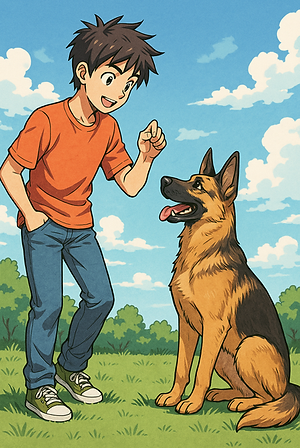
Basic Training – Building Strong Foundations
Every dog, no matter their age, breed, or background, benefits from learning a set of foundation skills. These basic exercises are not only practical for daily life but also form the building blocks for more advanced training or dog sports. Teaching them strengthens communication, builds trust, and makes life safer and more enjoyable for both dog and owner.
Why Start with the Basics?
Basic training is not about creating a perfect obedience champion. It is about giving your dog the tools they need to live calmly and confidently in the human world. These exercises encourage focus, improve self-control, and make everyday situations easier to manage — from greeting visitors politely to walking safely along busy streets.
Most importantly, training sessions provide mental stimulation. Even short, positive sessions help your dog feel engaged and fulfilled, reducing boredom and problem behaviours.

Foundation Exercises Every Dog Should Know
Sit
A simple but powerful exercise. Teaching “sit” gives your dog a default polite behaviour. It can be used at doorways, when greeting people, or whenever you need calmness and control.
Down
Encourages relaxation and is useful in situations where you want your dog to settle — whether in a café, at the vet’s, or at home.
Stay
“Stay” builds patience and self-control. It keeps your dog safe when you need them to remain in one spot, and it develops trust between you and your dog.
Come (Recall)
One of the most important commands for safety. A reliable recall means your dog will return to you when called, even with distractions around.
Leave It
Teaches your dog to ignore or avoid something on cue. Essential for preventing them from picking up harmful or unwanted items.
Drop It
Encourages your dog to release objects willingly. This is particularly important for safety if they grab something dangerous, but also useful for games of fetch and play.
Wait
Similar to “stay” but less formal. “Wait” is used for brief pauses — at a doorway, before crossing the road, or before being released for a meal.
Heel / Loose Lead Walking
Walking calmly on a lead makes daily life more enjoyable for everyone. Teaching your dog to walk by your side or on a loose lead prevents pulling and helps them focus in distracting environments.
Watch Me / Focus
A vital foundation skill that teaches your dog to give you eye contact on cue. This focus is the starting point for learning new exercises and maintaining attention in busy environments.
Settle / Place
Encourages your dog to relax calmly on a bed, mat, or designated spot. This is invaluable for building impulse control and creating a calm household companion.
Keeping Training Positive
All exercises should be taught using positive reinforcement — rewarding the behaviours you want with food, toys, or praise. This keeps learning enjoyable for your dog and strengthens your bond. Avoid punishment or harsh corrections; training should always be about building trust, not fear.
Next Steps
Consistency is the key to success. Regular, short training sessions will help your dog progress far more effectively than long, occasional ones. These foundation skills are the stepping stones to more advanced training, sports, and activities.



